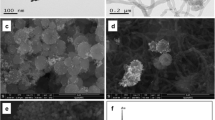Abstract
The replacement of antibodies by molecularly imprinted polymers (MIPs) has been investigated for many decades. However, indirect protocols (including natural primary and secondary antibodies) are still utilized to evaluate the ability of MIP thin films to recognize target molecules. MIPs can be prepared as either a thin film or as particles, and cavities that are complementary to the template can be generated on their surfaces. We have prepared thin film MIPs and particle MIPs prepared by solvent evaporation and phase inversion, respectively, from solutions of poly(ethylene-co-vinyl alcohol) (pEVAL) in the presence of the target analytes amylase, lysozyme, and lipase. These were first adsorbed on MIP thin films and by MIP particles that contain fluorescent quantum dots. Sandwich fluoroimmunoassays were then conducted to quantify them in MIP-coated 96-well microplates. The method was applied to determine amylase in saliva, and results were compared with a commercial analytical system.





Similar content being viewed by others
References
Yang M, Han A, Duan J, Li Z, Lai Y, Zhan J (2012) Magnetic nanoparticles and quantum dots co-loaded imprinted matrix for pentachlorophenol. J Hazard Mater 237–238:63–70. doi:10.1016/j.jhazmat.2012.07.064
Lee M-H, Thomas JL, Ho M-H, Yuan C, Lin H-Y (2010) Synthesis of magnetic molecularly imprinted poly(ethylene-co-vinyl alcohol) nanoparticles and their uses in the extraction and sensing of target molecules in urine. ACS Appl Mater Interfaces 2(6):1729–1736. doi:10.1021/am100227r
Lee M-H, Chen Y-C, Ho M-H, Lin H-Y (2010) Optical recognition of salivary proteins by use of molecularly imprinted poly(ethylene-co-vinyl alcohol)/quantum dot composite nanoparticles. Anal Bioanal Chem 397(4):1457–1466. doi:10.1007/s00216-010-3631-x
Lin H-Y, Ho M-S, Lee M-H (2009) Instant formation of molecularly imprinted poly(ethylene-co-vinyl alcohol)/quantum dot composite nanoparticles and their use in one-pot urinalysis. Biosens Bioelectron 25(3):579–586
Whitcombe MJ, Chianella I, Larcombe L, Piletsky SA, Noble J, Porter R, Horgan A (2011) The rational development of molecularly imprinted polymer-based sensors for protein detection. Chem Soc Rev 40(3):1547–1571
Lin CI, Joseph AK, Chang CK, Lee YD (2004) Molecularly imprinted polymeric film on semiconductor nanoparticles: analyte detection by quantum dot photoluminescence. J Chromatogr A 1027(1–2):259–262. doi:10.1016/j.chroma.2003.10.037
Diltemiz SE, Say R, Büyüktiryaki S, Hür D, Denizli A, Ersöz A (2008) Quantum dot nanocrystals having guanosine imprinted nanoshell for DNA recognition. Talanta 75(4):890–896. doi:10.1016/j.talanta.2007.12.036
Ge S, Zhang C, Yu F, Yan M, Yu J (2011) Layer-by-layer self-assembly CdTe quantum dots and molecularly imprinted polymers modified chemiluminescence sensor for deltamethrin detection. Sensors Actuator B: Chem 156(1):222–227. doi:10.1016/j.snb.2011.04.024
Zhang W, He X-W, Chen Y, Li W-Y, Zhang Y-K (2012) Molecularly imprinted polymer anchored on the surface of denatured bovine serum albumin modified CdTe quantum dots as fluorescent artificial receptor for recognition of target protein. Biosens Bioelectron 31(1):84–89. doi:10.1016/j.bios.2011.09.042
Zhang W, He X-W, Chen Y, Li W-Y, Zhang Y-K (2011) Composite of CdTe quantum dots and molecularly imprinted polymer as a sensing material for cytochrome c. Biosens Bioelectron 26(5):2553–2558. doi:10.1016/j.bios.2010.11.004
Surugiu I, Ye L, Yilmaz E, Dzgoev A, Danielsson B, Mosbach K, Haupt K (2000) An enzyme-linked molecularly imprinted sorbent assay. Analyst 125(1):13–16
Surugiu I, Danielsson B, Ye L, Mosbach K, Haupt K (2001) Chemiluminescence imaging ELISA using an imprinted polymer as the recognition element instead of an antibody. Anal Chem 73(3):487–491. doi:10.1021/ac0011540
Piletsky SA, Piletska EV, Bossi A, Karim K, Lowe P, Turner APF (2001) Substitution of antibodies and receptors with molecularly imprinted polymers in enzyme-linked and fluorescent assays. Biosens Bioelectron 16(9–12):701–707. doi:10.1016/S0956-5663(01)00234-2
Huang C-Y, Tsai T-C, Thomas JL, Lee M-H, Liu B-D, Lin H-Y (2009) Urinalysis with molecularly imprinted poly(ethylene-co-vinyl alcohol) potentiostat sensors. Biosens Bioelectron 24(8):2611–2617
Lee M-H, Thomas JL, Tseng H-Y, Lin W-C, Liu B-D, Lin H-Y (2011) Sensing of digestive proteins in saliva with a molecularly imprinted poly(ethylene-co-vinyl alcohol) thin film coated quartz crystal microbalance sensor. ACS Appl Mater Interfaces 3(8):3064–3071. doi:10.1021/am2005724
Young T-H, Huang J-H, Chuang W-Y (2002) Effect of evaporation temperature on the formation of particulate membranes from crystalline polymers by dry-cast process. Eur Polym J 38(1):63–72. doi:10.1016/S0014-3057(01)00183-5
Voets IK, Cruz WA, Moitzi C, Lindner P, Arêas EPG, Schurtenberger P (2010) DMSO-induced denaturation of Hen egg white lysozyme. J Phys Chem B 114(36):11875–11883. doi:10.1021/jp103515b
Lin H-Y, Hsu C-Y, Thomas JL, Wang S-E, Chen H-C, Chou T-C (2006) The microcontact imprinting of proteins: the effect of cross-linking monomers for lysozyme, ribonuclease A and myoglobin. Biosens Bioelectron 22(4):534–543
Young T-H, Chen L-W, Cheng L-P (1996) Membranes with a microparticulate morphology. Polymer 37(8):1305–1310
Apodaca DC, Pernites RB, Ponnapati RR, Del Mundo FR, Advincula RC (2010) Electropolymerized molecularly imprinted polymer films of a Bis-Terthiophene dendron: folic acid quartz crystal microbalance sensing. ACS Appl Mater Interfaces 3(2):191–203. doi:10.1021/am100805y
Acknowledgments
We appreciate financial supports from National Science Council of ROC under Contract No. NSC 100-2314-B-390-001-MY3 and NSC 101-2220-E-390-001-.
Author information
Authors and Affiliations
Corresponding author
Rights and permissions
About this article
Cite this article
Lee, MH., Thomas, J.L., Chen, YC. et al. The complete replacement of antibodies by protein-imprinted poly(ethylene-co-vinyl alcohol) in sandwich fluoroimmunoassays. Microchim Acta 180, 1393–1399 (2013). https://doi.org/10.1007/s00604-013-0995-6
Received:
Accepted:
Published:
Issue Date:
DOI: https://doi.org/10.1007/s00604-013-0995-6




